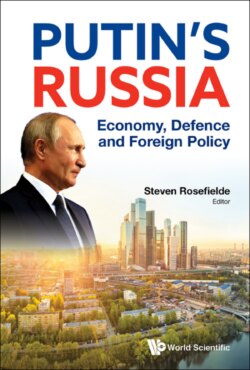Читать книгу Putin's Russia - Группа авторов - Страница 33
На сайте Литреса книга снята с продажи.
Results of Innovation Policy as Evidence
ОглавлениеThe Kremlin’s aggressive policymaking has had an impact on Russia’s innovation, especially after the year 2009 (Mizobata, 2016). Russia has increased innovation-related investment and the share of the new innovative goods. R&D expenditure in coke and petroleum products, transportation vehicles, and chemical was especially large, with mixed results.
Innovation-related investment increased, and R&D expenditure grew during the 2000s (Figure 2). However, this increase may be overstated because R&D share of the GDP has been puzzlingly stagnant at just 1%. This is only half of the OECD (The Organisation for Economic Co-operation and Development) average and smaller than that of the other emerging countries. Moreover, the contribution of businesses to R&D expenditure was tiny (0.3% of the GDP). The state provides the lion’s share of R&D financing (Figure 3). The public–private structure is the reverse of many OECD countries.
The term “service trade balance” refers to international innovation value transfer. Russia recorded a remarkable expansion in imports (Figure 4).10 Gains were obtained from oil and gas finance technology transfer as well as machinery and equipment imports. Some activities, such as machinery design, leasing, and servicing, continue to depend on foreign sources. Dependence on imports has remained, despite import substitution stimulating the effects of economic sanctions.
Figure 2:R&D expenditure trend.
Note: Expenditure indicated in the left axis in billion ruble, and % of GDP in the right axis.
Source: Rosstat, http://www.gks.ru, accessed on 1 May 2019.
Figure 3:R&D expenditure by source.
Note: State = budget + non-budget, enterprises = enterprises + foreign capital, others = own funds.
Source: Rosstat, http://www.gks.ru, accessed on 1 October 2018.
Figure 4:Service trade deficits (billion dollars).
Note: Total service import indicated in the right axis, and service concerning innovation and others are balance of trade indicated in the left axis.
Source: Central Bank of Russia, http://www.cbr.ru, accessed on 20 May 2019.
The number of R&D staff has declined. Collapse of the Soviet Union destroyed research jobs. The supply of researchers fell sharply during the first half of the 1990s and declined 20.5% more during the period 2000–2017 (Figure 5). The number of assistants plummeted by around 30%, underscoring the magnitude of the brain drain. Such changes distort the age structure of the researchers. Even though the number of young scholars has increased, a sharp reduction in the number of middle-aged staffs engaged in R&D suggests that people with potential to conduct good research have left the country for greener pastures.
As for R&D organisations, after showing a decline in the 2000s, their numbers recently increased. R&D research in state and higher educational institutions rose enough to offset declines in enterprise-based R&D activities, highlighting the state-led character of Russian innovation (Figure 6). Industrial organisations with R&D departments and higher education organisations increased sharply after 2014, reflecting the potential benefits of enterprises and industry–university cooperation.
Figure 5:Number of researchers engaging in R&D in Russia (in thousands).
Source: Rosstat, http://www.gks.ru, accessed on 1 May 2019.
Figure 6:R&D organisations.
Source: Rosstat, http://www.gks.ru, accessed on 1 May 2019.
The statistical data (Gokhberg et al., 2018) show an increase in the shares and services of the total number of shipments after 2010. The nominal value increased 24.2 times during the period 2000–2016. The share of innovative exports increased 30.3 times during the period 2000–2013 (peak). The largest advances were in transportation machines, coke and oil products, computer and electronics, metalware and chemicals including medicine. The share of innovation goods is high in metallurgy and transportation equipment (by foreign transfer)11, and in the manufacturing sector, the top three are oil refining, chemicals and machineries (automobile, power plant, and defence). These asymmetries reflect the government’s innovation and modernisation priorities. Innovation in the private sector is progressing slowly (World Bank, 2018, pp. 9–10).
Figure 7:Change of labour productivity by sector (data for the year 2002 in one hundred).
Source: Rosstat, http://www.gks.ru, accessed on 1 May 2019.
Gazprom is making progress on its industrial digital platform (World Bank, 2018, pp. 67–69). The auto company KAMAZ launched a Digitalisation Programme. The UAC, whose main product is the aircraft, created a network of higher education institutions and invested in the Skolkovo Innovation Fund. UAZ invested in digital factories. Promobot produced robots and Conundrum is automating (Ekspert, No. 15, 8–14 April 2019).
The macroeconomic effect of this innovation has been slight, even though labour productivity improved in the 2000s (Figure 7). Productivity growth in manufacturing after 2009 has been remarkable12 and agricultural productivity has recently risen. According to the World Bank (2018, pp. 80–85), the digital transformation has targeted agriculture as a top priority for export growth.
Nonetheless, the innovation impact to the economy has been modest. The innovation sphere is limited to priority sectors and the government-led sectors, and high dependence on the state budget has fostered protectionism. In sum, “Russia’s technological level is insufficient” (Idrisov et al., 2018, pp. 12–13). The share of mineral resources in export continues to be high and the Russian economy remains vulnerable to volatile oil price (Figure 1).
